Do Autistic People Talk To Themselves?

Exploring the Nature and Purpose of Self-Talk in Autistic Individuals
Self-talk is a common and multifaceted behavior observed in many autistic individuals. Often misunderstood, it plays a significant role in how they process emotions, organize thoughts, and navigate their environment. This article delves into the reasons why autistic people talk to themselves, exploring its functions, significance, and the scientific theories behind this behavior.
What Is Self-Talk and How Does It Manifest in Autism?
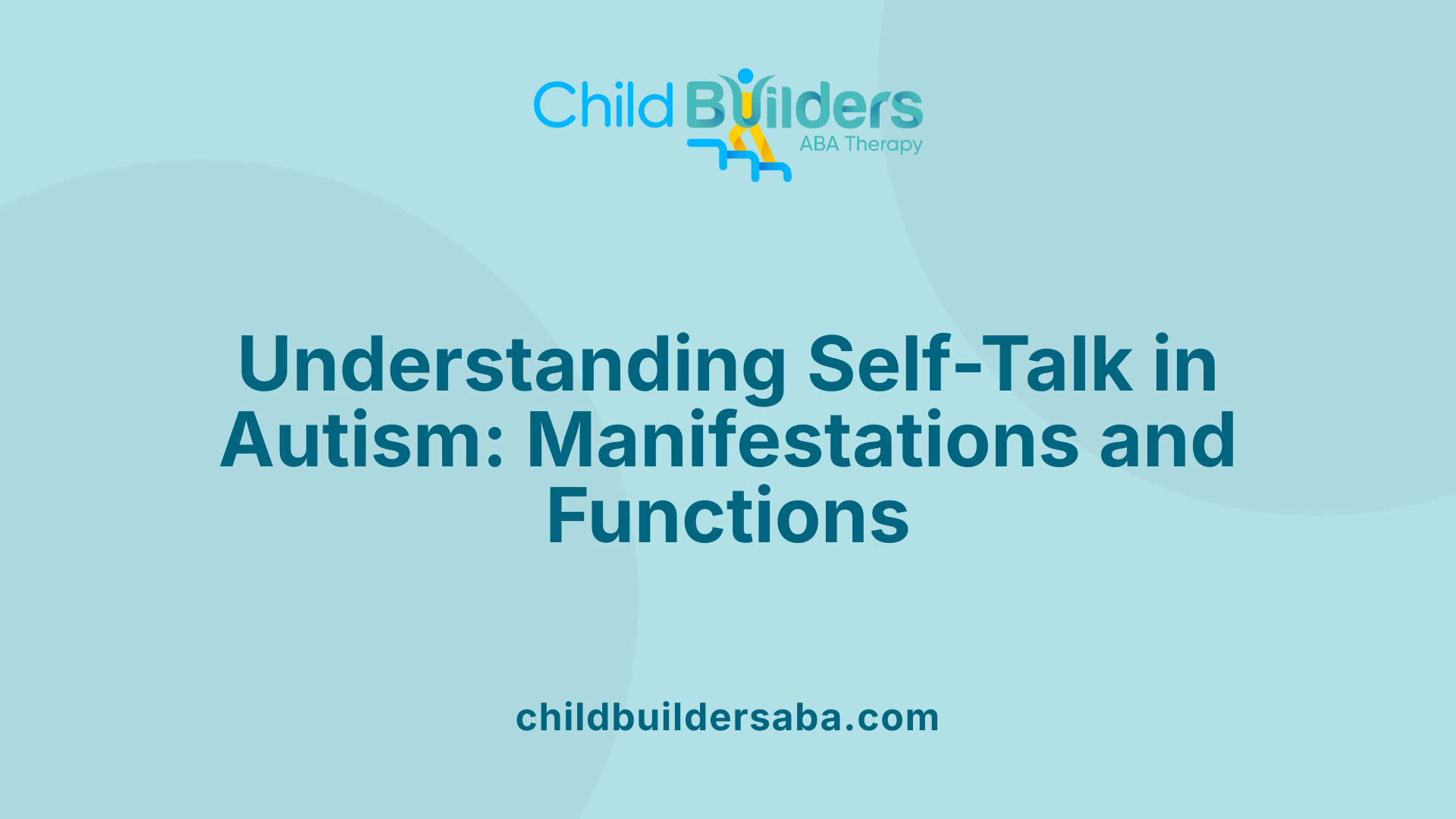 Self-talk refers to the act of talking to oneself, either aloud or silently, which plays an important role in cognitive processes such as thought evaluation, emotional regulation, and problem-solving. Both internal and external forms exist, with individuals often engaging in spoken words, repetitive phrases, or imaginary conversations.
Self-talk refers to the act of talking to oneself, either aloud or silently, which plays an important role in cognitive processes such as thought evaluation, emotional regulation, and problem-solving. Both internal and external forms exist, with individuals often engaging in spoken words, repetitive phrases, or imaginary conversations.
In autistic individuals, self-talk can manifest as various behaviors, including full conversations, repetitions, echolalia (the repetition of heard words or phrases), or vocal stimming. Echolalia is common and may occur during wakefulness or during specific situations like sleep, serving as a way to process language or manage emotions. Sometimes, autistic people script lines from movies, TV shows, or YouTube videos, which can provide comfort and a sense of security.
While in neurotypical individuals self-talk might be more subtle or less frequent, in autism it often takes on amplified roles, such as assisting with emotional regulation or navigating social environments. It may also be misinterpreted or occur in inappropriate contexts, but it is not inherently problematic.
Talking to oneself is not exclusive to autism; rather, it is a characteristic that many autistic individuals use constructively. It supports organizing thoughts, calming down during stressful moments, and practicing social interactions. Recognizing the adaptive functions of self-talk helps foster understanding and acceptance among caregivers and professionals.
In summary, self-talk in autism appears in various forms—full conversations, repetitions, echolalia—that serve essential functions like emotional support, problem-solving, and social understanding. It is a natural behavior that, with appropriate strategies, can be managed effectively to support well-being.
Functions and Benefits of Self-Talk for Autistic People
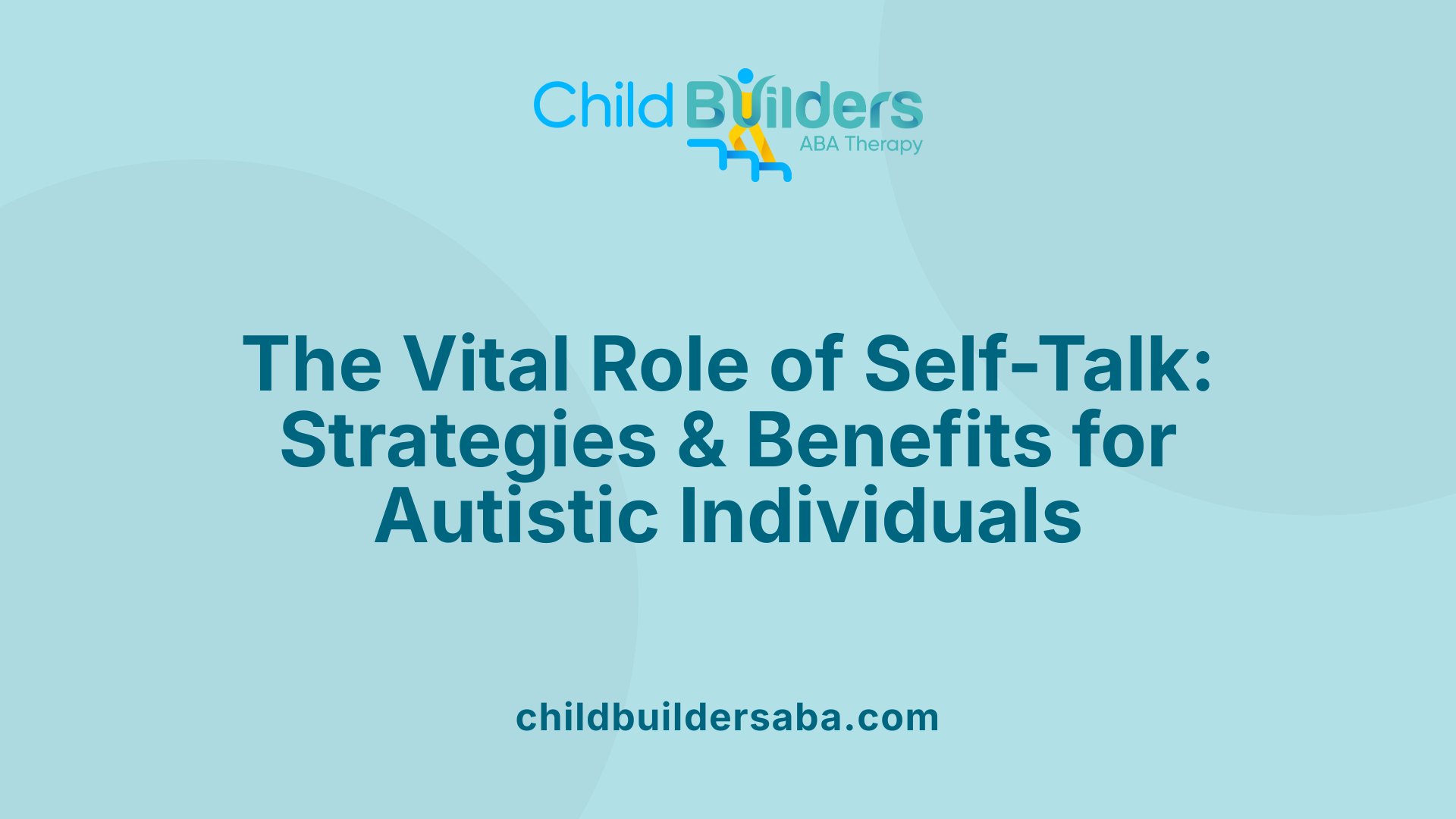
What is the significance and function of self-talk in autism?
Self-talk in autism serves multiple important roles, helping individuals manage their internal and external worlds. It is a tool for emotional regulation, allowing individuals to calm themselves during stressful or overwhelming moments. Self-talk also supports cognitive functions such as problem-solving, organizing thoughts, and reinforcing memory. It can take various forms—from full conversations to repetitive phrases or echolalia—and may be audible or internal.
This behavior helps with understanding complex tasks and navigating social situations, especially when Theory of Mind—an understanding of others’ mental states—is challenging. In addition, self-talk acts as a coping strategy for sensory overload, anxiety, and other difficult situations, by providing a sense of control and reassurance.
Why do autistic people talk to themselves?
People with autism often engage in self-talk to process information more clearly and regulate their emotions. This behavior helps in organizing thoughts, especially during demanding tasks or social challenges. It can serve as a rehearsal for upcoming conversations, allowing individuals to prepare responses and build confidence.
Self-talk also functions as a calming technique, helping to soothe feelings of stress or anxiety. It supports self-awareness and self-regulation, which are crucial for daily functioning. Importantly, this behavior often helps individuals understand their environment better and feel more in control of their reactions.
Supporting cognitive and emotional needs
In addition to emotional regulation, self-talk nurtures executive functioning skills. It helps break down complex problems into small, manageable steps and supports memory recall. For children and adults alike, talking to oneself provides an ongoing internal dialogue that facilitates understanding, planning, and reflection.
Managing sensory and emotional challenges
Self-talk can serve as a strategy to cope with sensory sensitivities and overwhelming stimuli. By verbalizing or internally repeating calming phrases, individuals can reduce overstimulation and regain focus.
While generally beneficial, excessive or inappropriate self-talk in social settings might lead to misunderstandings. Strategies such as teaching more appropriate replacement behaviors or increasing participation in structured activities can help manage its occurrence.
Additional benefits and considerations
Overall, self-talk is a natural, functional aspect of autism for many individuals. Recognizing it as a positive coping tool rather than a problem helps promote acceptance. Proper management and understanding can maximize its benefits, supporting emotional well-being and daily functioning.
| Aspect | Function | Additional Notes |
|---|---|---|
| Emotional regulation | Calms anxiety, manages stress | Repetitive phrases are common |
| Cognitive skills | Problem-solving, memory | Helps break down complex tasks |
| Social understanding | Practicing social cues | Aids in rehearsing conversations |
| Sensory coping | Reduces overstimulation | Verbal or internal calming |
| General benefits | Self-regulation, self-awareness | Supports independence |
Understanding the diverse roles of self-talk in autism fosters a more accepting attitude and encourages tailored strategies to support individuals' needs.
Nighttime Self-Talk and Sleep Disorders in Autism
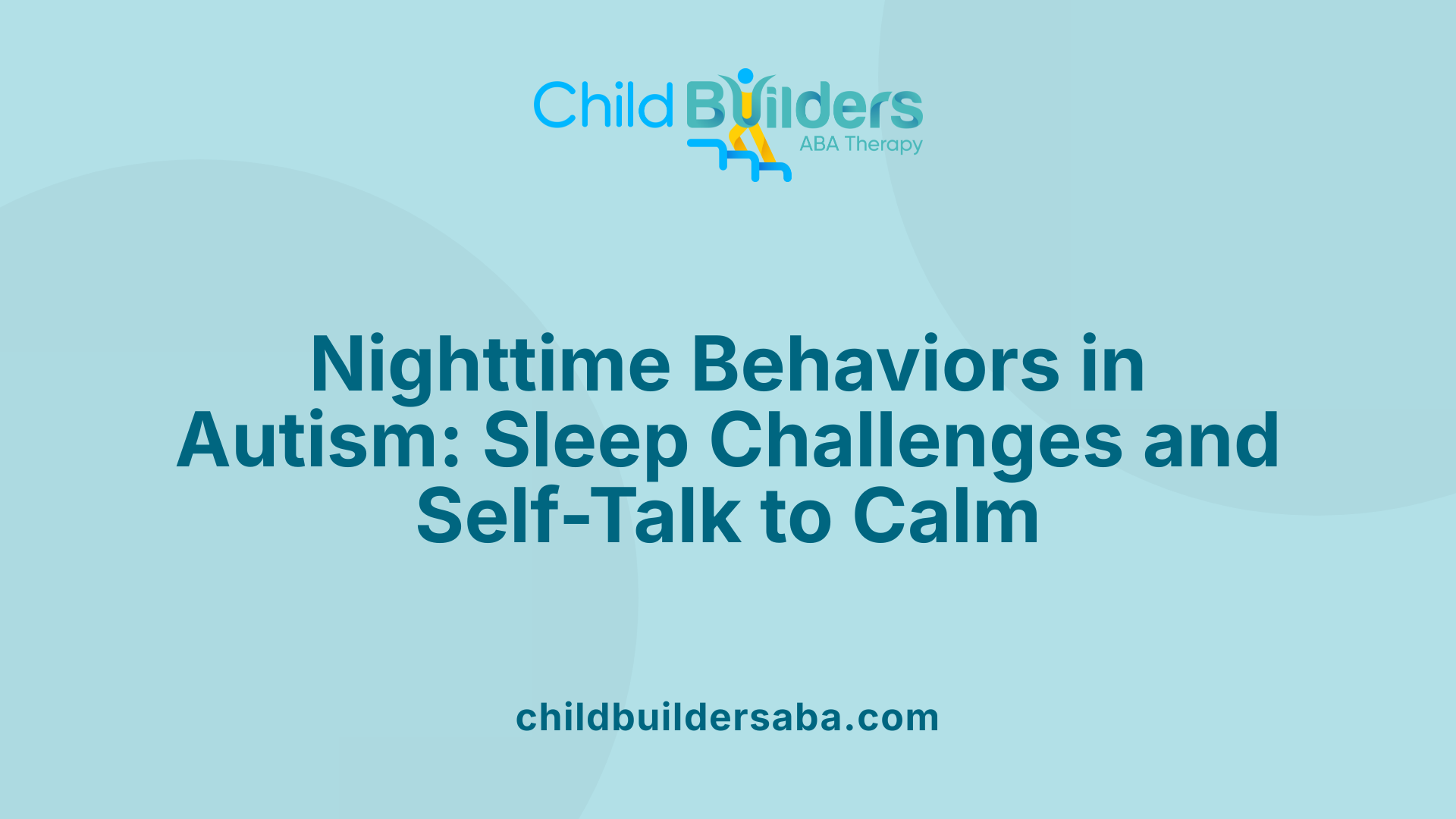
Prevalence of sleep disorders like parasomnias, sleepwalking, and sleep talking
Many autistic individuals experience sleep difficulties, including parasomnias such as sleepwalking and sleep talking. These conditions involve abnormal movements, behaviors, or emotional reactions during sleep. Sleep talking, in particular, is quite common and can range from quiet mumbling to loud conversations. Often, these behaviors happen during transitions between sleep and wakefulness and are usually forgotten by the person the next day. Such sleep disturbances can significantly impact overall well-being and daily functioning.
Nighttime scripting as a source of comfort or emotional regulation
Autistic individuals often engage in scripting—repeating lines from movies, TV shows, or YouTube—to find comfort and manage emotions. At night, scripting can become a calming activity, helping to reduce anxiety or nervousness. It is often done in private spaces like bedrooms or bathrooms, and may involve rehearsing conversations, processing feelings, or seeking reassurance. This self-directed practice provides a sense of control and predictability, which is especially comforting in quiet, solitary moments.
Relationship between sleep disturbances and self-talk behaviors at night
Nighttime self-talk may be closely linked to sleep disruptions such as parasomnias and anxiety. When experiencing sleep disturbances, individuals might talk aloud to help themselves relax or to process complex thoughts and emotions. For some, vocalizing during sleep or in transitional states offers a way to cope with overstimulation or emotional tension. While these behaviors can seem intrusive, they often serve as a mechanism for self-soothing, helping maintain a sense of calm during challenging nights.
The role of stress, anxiety, and sensory overload in nocturnal self-talk
In autism, stress, anxiety, and sensory overload can heighten the likelihood of engaging in self-talk or other nocturnal behaviors. Quiet environments and reduced external stimuli can trigger or exacerbate these behaviors as individuals attempt to regulate their internal states. When overwhelmed, they may turn to repetitive phrases or scripting to regain a sense of control and emotional balance. Managing these factors through good sleep hygiene and sensory modulation strategies can help reduce the intensity and frequency of nighttime self-talk behaviors.
Are these behaviors indicative of underlying medical issues?
It's important to differentiate between typical self-regulatory behaviors and signs of medical or psychological concerns. Frequent, severe, or disruptive behaviors—particularly if accompanied by abnormal movements, emotional shifts, or significant sleep disruption—may signal underlying issues such as sleep disorders or mental health conditions. Consulting healthcare professionals, including sleep specialists, is advisable to evaluate the root causes and develop suitable interventions. Using strategies like improving sleep routines and, if appropriate, melatonin supplementation can significantly improve sleep quality and reduce nighttime self-talk.
| Aspect | Description | Additional Notes |
|---|---|---|
| Common sleep disorders | Parasomnias, sleepwalking, sleep talking | Often occur during sleep transitions, usually forgotten |
| Functions of nighttime scripting | Comfort, emotional regulation, anxiety reduction | Can be performed alone, often in private spaces |
| Impact on daily life | Sleep disruptions may affect mood and functioning | Proper management improves well-being |
| Relationship with stress | Overstimulation and anxiety exacerbate behaviors | Sensory regulation strategies can help |
| When to seek help | Severe or persistent behaviors, other symptoms | Professional assessment recommended |
Theories and Explanations for Self-Talk in Autism
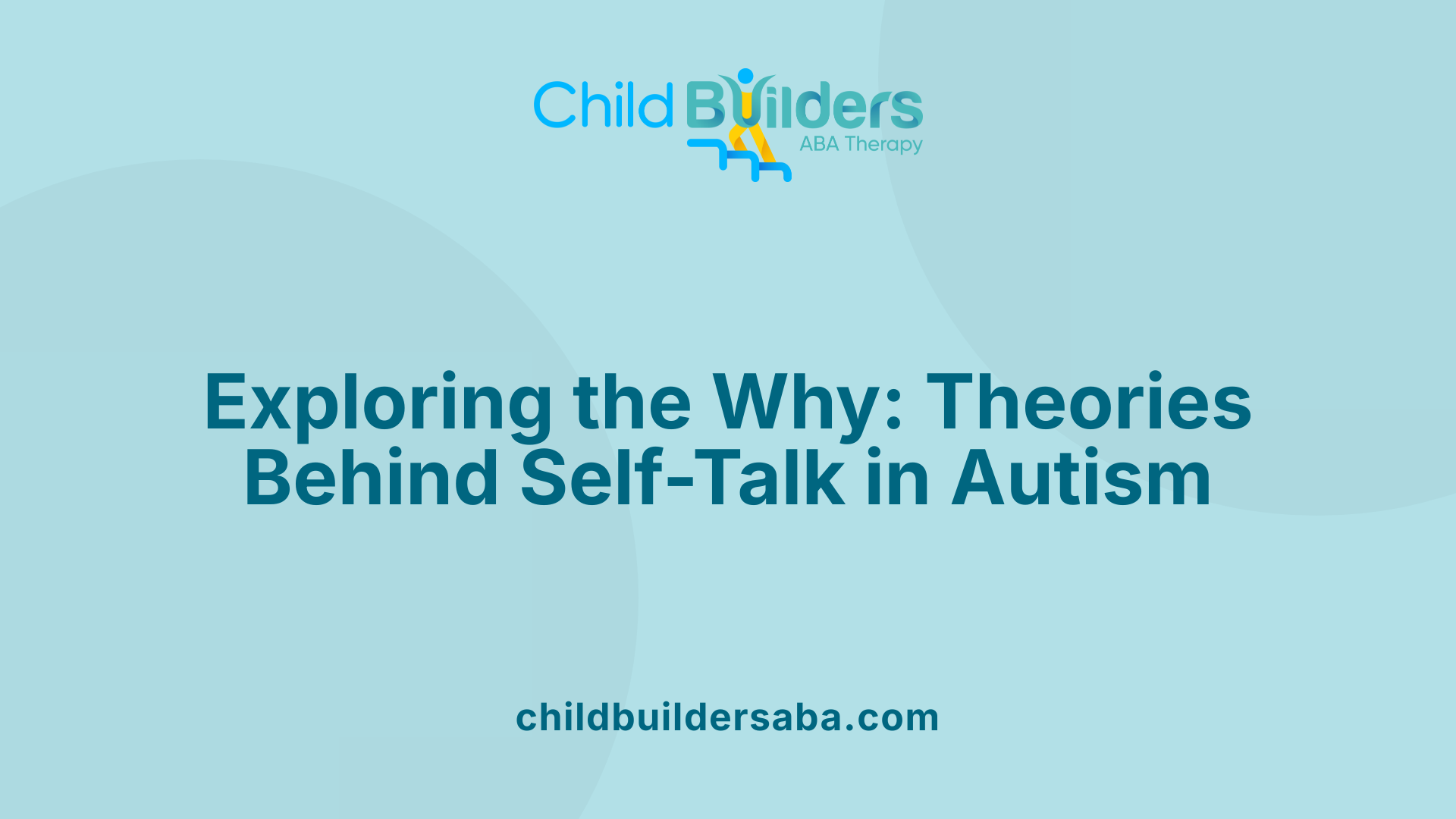
What are some theories or explanations regarding self-talk in autism?
Self-talk in autism is often viewed as an unconventional form of inner speech that plays a significant role in learning, emotional regulation, and social understanding. Many experts believe that differences in self-talk are linked to challenges with theory of mind—the ability to understand others’ mental states—and self-awareness. These impairments can be specific, affecting how autistic individuals manage internal dialogue or perspective-taking.
The development of inner speech, which is crucial for self-regulation and social interaction, may not follow typical patterns in autism. For some, this leads to behaviors like echolalia—repeating heard phrases—or repetitive, scripted conversations. Interestingly, individuals with higher IQs might experience more complex self-talk and can sometimes feel emotional distress or frustration over these differences. Overall, self-talk serves not only as a coping mechanism but also as a developmental area influenced by cognitive and emotional factors.
How do developmental and psychological factors influence self-talk behaviors?
Developmental maturity of internal speech heavily influences how self-talk appears in autistic people. As children grow, they usually develop more internal dialogue; in autism, this process can be delayed, unusual, or incomplete.
Psychological differences such as mindblindness—a difficulty in understanding others' intentions and thoughts—impact how self-talk is used. The double empathy problem, which describes the mutual misunderstandings between autistic and non-autistic people, also affects social interactions and how self-talk functions as a tool for practicing social skills and navigating complex feelings.
These factors collectively influence the nature of self-talk, determining whether it is primarily functional—helping to organize thoughts and manage emotions—or repetitive and echo-like. The diversity in self-talk behaviors reflects the broader variations in developmental trajectories and psychological experiences among autistic individuals.
| Aspect | Influence | Details |
|---|---|---|
| Development of internal speech | Maturation | Delays or differences affect self-regulation and social understanding |
| Theory of mind | Perspective-taking | Impacts social communication and self-reflective speech |
| Executive functioning | Problem-solving | Influences the use of self-talk for organizing tasks |
| Emotional regulation | Stress management | Self-talk helps calm or motivate in various situations |
| Cognitive ability (IQ) | Complexity of self-talk | Higher IQ may lead to more nuanced or distressing self-talk |
Understanding these interconnected factors helps in recognizing the multifaceted role self-talk plays in the lives of autistic individuals, supporting their development, emotional health, and social skills.
Managing Self-Talk and Promoting Healthy Communication Skills
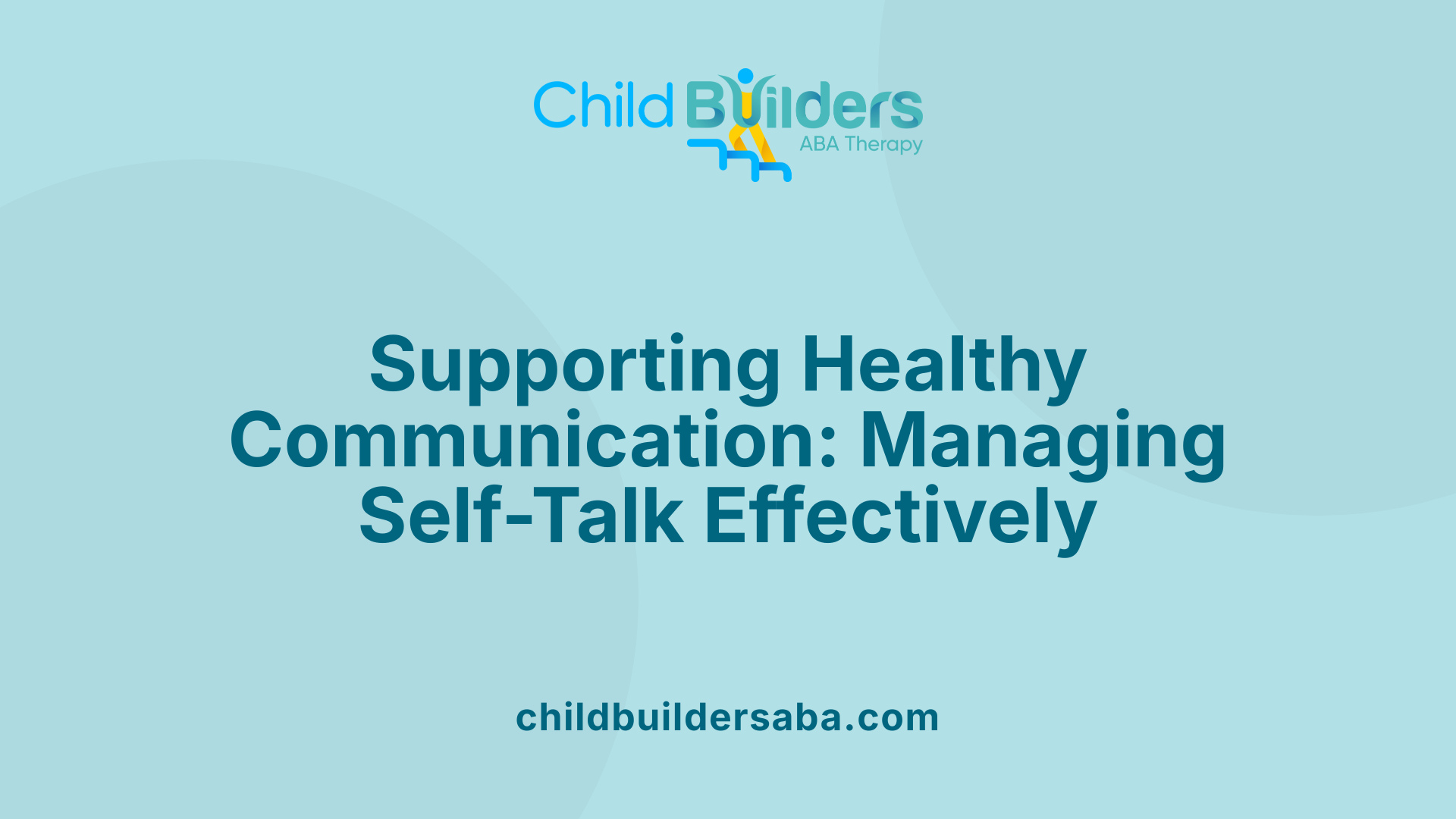
Strategies for managing excessive or inappropriate self-talk
Self-talk in autistic individuals serves many functional purposes, such as emotional regulation, problem-solving, and organizing thoughts. However, when it becomes excessive or occurs in inappropriate contexts, it can interfere with social interactions or daily functioning. Managing this behavior involves a combination of support strategies tailored to individual needs.
First, replacing behaviors through teaching alternative communication skills is essential. For example, encouraging verbal or non-verbal expressive behaviors can provide more appropriate outlets for emotions or needs.
Increasing engagement in structured activities can also reduce idle time that might trigger repetitive self-talk. Activities that promote focus, social interaction, and meaningful participation help divert attention from unnecessary self-dialogue.
Creating supportive environments where individuals feel safe to express themselves without judgment contributes to healthier communication. Using visual supports, social stories, and clear routines can facilitate understanding and reduce anxiety that may lead to excessive self-talk.
Cognitive-behavioral strategies are effective tools for improving self-regulation. Techniques such as mindfulness, relaxation exercises, and cognitive restructuring can help individuals manage emotional responses and limit disruptive self-talk.
Finally, involving caregivers, educators, and therapists in consistent routines and strategies ensures that positive behaviors are reinforced and maladaptive patterns are addressed collaboratively. Overall, support aimed at teaching replacement behaviors, providing engaging activities, and fostering emotional regulation skills creates an environment where positive self-talk can flourish and serve its beneficial purposes.
The Balance Between Self-Talk and Social Functioning
Understanding the social context of self-talk
Self-talk is a common behavior among individuals with autism and can serve important emotional and cognitive functions. However, its expression—whether as internal dialogue, audible repetition, or echolalia—may sometimes be misinterpreted in social settings. In social interactions, excessive or inappropriate self-talk may lead to misunderstandings or social discomfort.
Despite these challenges, it is vital to recognize that self-talk is part of many autistic people's way of processing their environment, calming themselves, or organizing their thoughts. By understanding the social context, caregivers and individuals can better navigate how and when to use self-talk effectively.
Strategies for social engagement and appropriate use of self-talk
Several approaches can facilitate the appropriate use of self-talk in social situations. Teaching replacement behaviors helps individuals channel their internal dialogue into more acceptable external behaviors.
Increasing participation in structured social activities allows practice of social norms and turns sharing space with others. It also provides opportunities to recognize cues for when self-talk might be less appropriate.
Building awareness of social norms is crucial. Social skills training can help individuals understand when talking aloud might be confusing or disruptive to others. This training often includes role-playing, prompt fading, and explicit instruction about appropriate communication.
Teaching social skills alongside self-talk management
Combining self-talk management with social skills education creates a balanced approach. This may involve teaching when and where self-talk is acceptable, such as during private moments or specific activities designed for processing thoughts.
Practicing self-awareness skills helps individuals recognize their own emotional states and cues that indicate they might need to use self-talk. Cognitive-behavioral techniques can promote adaptability by helping them modify their behavior in various social contexts.
Strategies to manage self-talk in social situations
Do you wonder if there are strategies to manage self-talk in social settings? The answer is yes. Approaches include teaching replacement behaviors, which could involve using visual cues or verbal prompts to redirect self-talk.
Increasing social participation provides real-life contexts to practice appropriate communication. This might be through group activities, peer-led sessions, or guided social stories.
Additionally, fostering awareness of social norms through explicit education can help individuals understand acceptable behaviors during interactions. Cognitive-behavioral approaches can support self-awareness and adaptation, helping reduce misunderstandings without eliminating the beneficial aspects of self-talk.
| Strategy | Description | Benefits |
|---|---|---|
| Replacement behaviors | Substitute self-talk with other activities or expressions | Promotes appropriate social interaction |
| Social skills training | Teaching social rules and cues | Enhances understanding and confidence |
| Self-awareness techniques | Recognizing emotional cues and when to use self-talk | Builds self-regulation and adaptability |
Effective management improves social experiences while respecting the functional uses of self-talk.
Embracing and Supporting Self-Talk in Autism
Understanding that self-talk is an integral part of many autistic individuals’ lives helps foster acceptance and support. Recognizing its functions as a tool for emotional regulation and cognitive processing can improve how caregivers, educators, and healthcare professionals approach this Behavior. Encouraging meaningful, appropriately timed self-talk, while teaching social awareness and skills, promotes a balanced and supportive environment where autistic individuals can thrive.
References
- Do Autistic People Talk to Themselves? All You Need to Know
- Adult with autism argues alone at night
- Self-Talk in Autism: Boosting Emotional Awareness & Cognitive Skills
- How to minimize self talk on children with ASD - Autism Partnership
- Do Autistic People Talk To Themselves? - Astra ABA
- Do People with Autism Talk to Themselves? Let's Explore
- Do Autistic People Talk to Themselves? All You Need to Know
- How to minimize self talk on children with ASD - Autism Partnership
- Exploring Self-Talk in Autism: Cognitive & Emotional Benefits



.jpg)

































































































